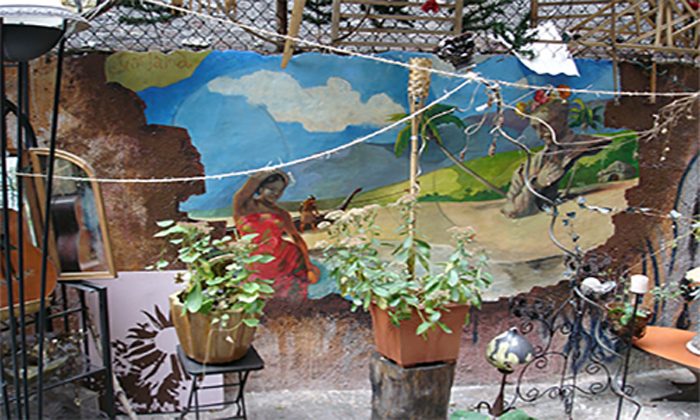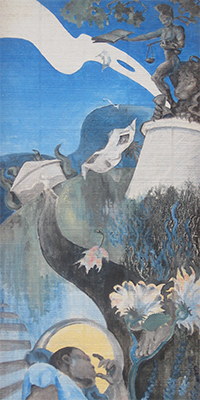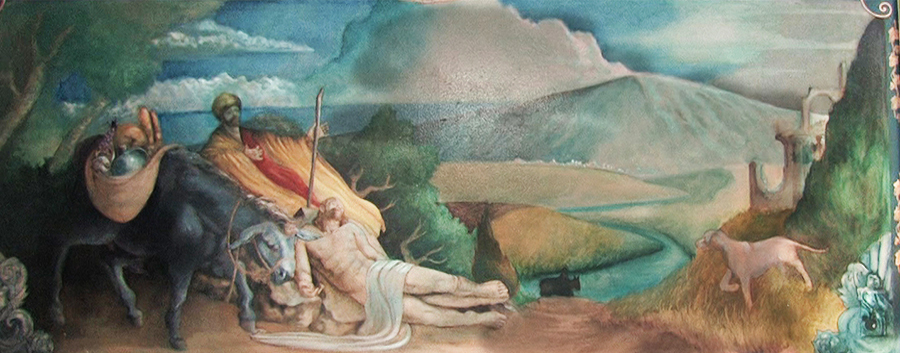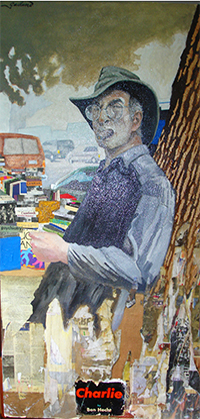In the summer of 2010, as the filmmaker, I met an itinerant painter named James Garland. Our chance encounter occurred shortly after my retirement from a 30-year career as an ABC News video editor in New York City. One day while visiting Dave, an Upper West Side friend, he took me down to his apartment courtyard to see the sculpture garden he was constructing. I discovered a hodgepodge of abandoned houseplants, discarded everyday objects, and all sorts of urban debris. Among the throwaways, I noticed someone curled up asleep. Dave said his collaborator, James, was taking a break from the labors of creating a mural: the backdrop for Dave’s creation. I took another look at the napping artist and was little impressed with his disheveled, homeless appearance.

When I returned to the courtyard a week later, I was so taken with the 10’ x 24’ dreamlike landscape on the cement wall that I asked James to allow me to film him in front of his mural. He self-consciously agreed to pose for my camera, but he was not hesitant to talk about his unconventional way of life as an artist. He mentioned his collector, Bill Blakemore, who, he said, had acquired a large number of James’ paintings: an odd coincidence. I happen to know Bill as a veteran newscaster at ABC-TV News. Could it be that Bill actually was a patron of this street person who slept in Central Park? My filmmaker’s curiosity was aroused. Shortly thereafter, I asked James if he would consider being the subject of my own documentary project; he seemed noncommittal and not keen on the idea.
Winter was approaching, when we bumped into one another. He was leaving for California; however, our coincidental meeting struck James as providential. To him, it was a sign we were destined to create a film together. His premonition sparked my hope that he would consent to filming. I urged him to stay in touch. If something with cinematic potential occurred, I might join him in Santa Monica with my camera gear—all the while thinking I would never hear from him again.
A few weeks later, at James’ behest, I received a call from John Kakavas, a financial planner in Santa Monica. He had discovered James on the beach painting Pacific shore scenes. They had become involved in planning a mural to be installed in John’s condo. They wondered if the creation of the mural possibly could be a sequence in a film of mine. With some reservation and great trepidation, I packed my Canon XH-A1 digital camera, lights and audio equipment. I flew to the coast and met them at John’s place with its panoramic view of the ocean.
They seemed to be in agreement about the concept of a 16-foot-long mural. In return for his creation, James would have his room, board, and art materials without charge. During that week of filming, they gave me their full support. After years as an often-stifled video editor, I felt empowered to be creating my personal documentary. By the time I left for New York, James sprawling canvas had received its first splashes of color.

My next shoot was in Chester, a rural village in Orange County, located 70 miles northwest of New York City. In late summer 2001, James was commissioned to create a mural to be displayed in front of the town's bookstore. It featured two of the village’s grain silos, which James portrayed as in flames. He is convinced only days after it was completed that his mural predicted the 9/11 World Trade Center attack. This extrasensory visualization, the so-called “Chester Prophecy,” is the canvas James most hoped audiences would witness. I was being increasingly drawn to his quirky state of mind.
When I returned to film the completion of the Pacific Bluffs mural, I was confronted with turmoil: James's undercurrent of prejudice toward John’s Catholicism had become an affront to John. He retaliated by sending James outdoors to sleep on the beach. James’s intolerance was also aggravating me, and I feared my production was about to be derailed.

John was insisting the mural’s style be more realistic: brighter and less sinister and not so abstract. I implored John to back off, but he was adamant and threatened to replace James with another painter. To my relief, the mural was ultimately reworked to John’s satisfaction, and I wince whenever I see James’s compromise replayed on screen.
We boarded a Greyhound to Baton Rouge, Louisiana, home of the Family Worship Center where, for over a decade, James has embraced the Jimmy Swaggart Ministries. I appreciated that the organization had no objection to the intrusion of my camera; in fact, Swaggart’s SonLife Broadcasting Network even donated footage from their weekly telecast to my project.

We next headed for James's winter home in Key West, Florida, where countless paintings have been left behind. I was eager to photograph those earlier works; then I discovered the mural the Good Samaritan on the soup kitchen wall in the Basilica of Saint Mary Star of the Sea. James gifted the painting to the kitchen staff in thanks for the meals they had provided him in harder times.
As was his custom, James returned to New York the following spring and to his haunts in Central Park. Now that production was winding down, I was determined to interview Bill Blakemore, the television journalist, who, in fact, was James’s patron. I looked forward to photographing the 150 paintings in Bill’s collection: the prime repository of James’s oeuvre.

After months of being put off, I finally got a hold of Bill. Our time together was well worth the wait. He spoke avidly about James’s unique talents; oddly, Bill collects no other artists’ work. Later, he let me into his apartment, which serves as a storehouse for the Garland Collection, so I could inventory the seven years of James’s production. I found the canvasses intermixed between stacks and stacks of old books, apparently another of Bill’s passions. I spent many hours photographing all the paintings not yet sure of which ones would appear in the final cut.

James rarely attempts portraiture; consequently, I was intrigued when he decided to create a close-up study of Charles Mysak, a gruff street vendor of second-hand books. In the era of eBooks, Charles still piles his merchandise atop a rickety table on fashionable Columbus Avenue. I shot James creating a collage-style portrait—one in which he repurposed discarded book jackets and other scraps of printed matter. I assumed the piece would be offered to Bill the book collector. I was right.
I came to realize that James was a true Francophile; on the other hand, he had never been outside of the United States. I thought if we went to France, the visit might become the film's finale I had been searching for. My funding of the trip would also express my gratitude for his unwavering support throughout our filmmaking odyssey. Voila! James and I landed in Paris just a year after undertaking our first shoot in Santa Monica.
To accommodate my tight production schedule, James immediately set up his easel and went to work. One evening after dinner, as he often did, James took a photograph while we were visiting the Notre Dame Cathedral. No sooner did the flash go off than I was reminded I had left my video camera gear at the restaurant. I panicked at the thought of losing my equipment; we raced back and were relieved to find everything intact.
Months later at home, I received an oversized UPS package containing James’s painting of Notre Dame. It is the only nighttime painting of his I have ever seen. Why had he sent it to me? I phoned him to ask. He reminded me his camera flash had triggered our mad race to retrieve my equipment. Harking back to our year of filmmaking, we share a moment that James has memorialized: Notre Dame by moonlight now shines from my living room wall.

